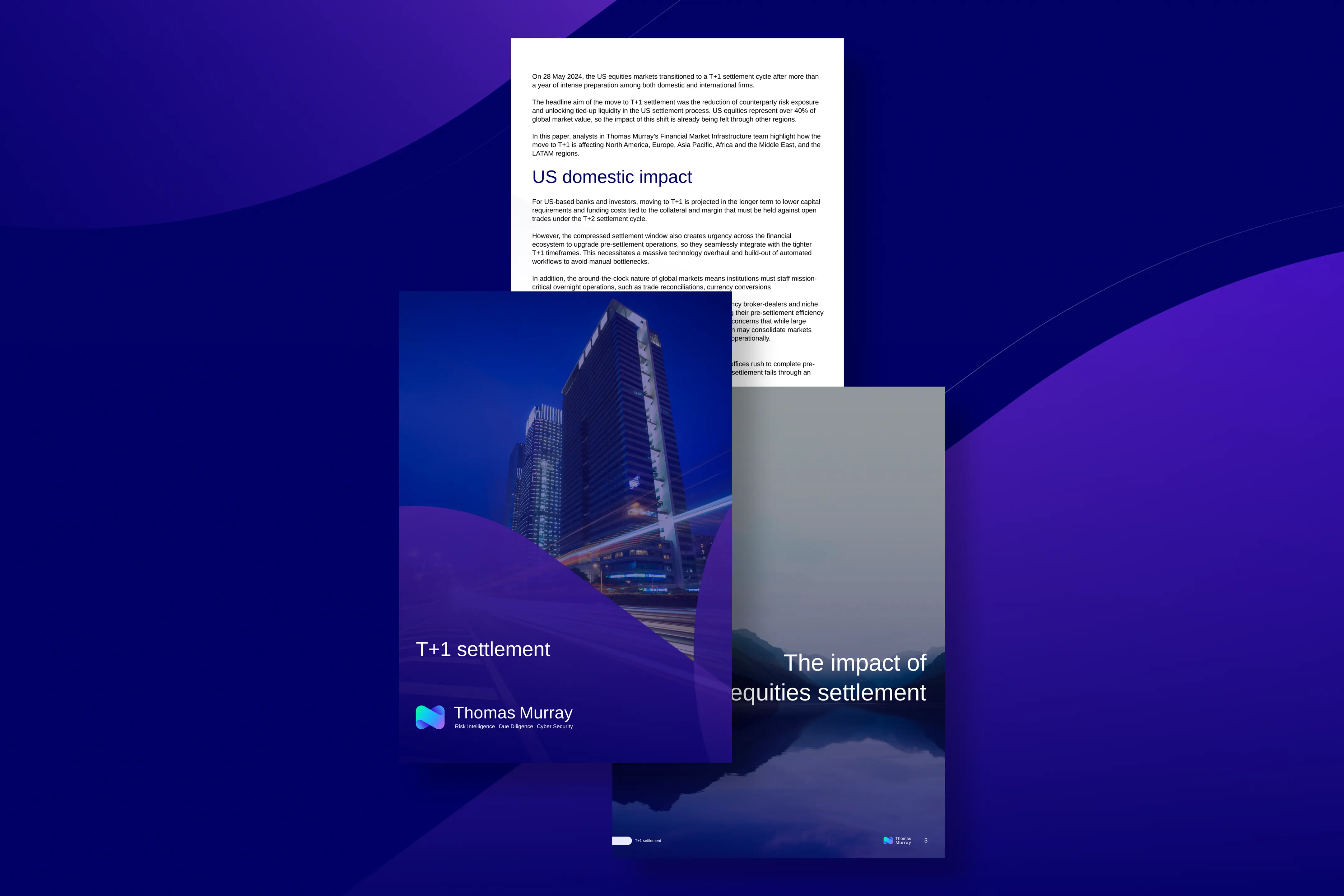India: A phased transition, rather than a big bang
When the US equities market transitioned to T+1 in May 2024, India had already been operating a T+1 settlement cycle for almost 18 months.
In contrast to the “big bang” transitional approach, as adopted by the US, India opted for a phased transition, lasting from February 2022 until January 2023. Under this approach, securities were grouped into tranches, which moved to T+1 on a monthly basis, starting with the smallest stocks by market capitalisation, and gradually working up to the largest in the final tranche.

The idea is to give the market time to acclimatise to the new cycles and time frames with the relatively illiquid securities, and ensure full preparedness by the time the most liquid stocks transitioned. This was considered preferable because of India’s adoption of a relatively short timeframe from commencing the T+1 project to going live with the transition (or, at least, a relatively short time frame when compared with the US’s). The market simply would not have been ready for a big bang approach.
On the other hand, a phased approach does involve the simultaneous running of two separate settlement cycles during the period – which is hugely operationally burdensome. Comparing the Indian and US approaches will be an interesting exercise for any markets looking to move to T+1 in future.
There were signs that the main driver for a move to T+1 in India was to increase liquidity for India’s extremely large domestic and retail markets. The initial T+1 Roadmap indicated this line of thinking, with plans to set participant instruction deadlines at 7.30pm on SD-1 (i.e. TD), while also recommending trade pre-funding as the norm. These proved to be points of contention, however, and following feedback from market participants, specifically on behalf of foreign portfolio investors (FPIs), the market agreed to move the confirmation deadline to 7.30am on the day of T+1, thus allowing investors more time to provide their instructions, while also removing any official pre-funding requirements.
Increased working hours for custodians
This was a very welcome change for the FPIs, but naturally, increased pressure on the local market participants and infrastructures to deal with any late or mismatched instructions, while ensuring cash and securities are in place for the 10.30am pay-in deadline. Although the majority of the 24-hour reduction was absorbed by the FMIs operationally, custodians have largely had to adopt increased working hours and adapted their shift patterns to ensure round-the-clock coverage and processing capabilities.
Initial feedback from the market was very positive, with the only minor issue relating to some early increases in FX fees as demand was squeezed into a tighter window on the morning of T+1. This lead to larger spreads, but no actual Indian rupee (INR) liquidity shortages.
Certain other measures have been used to ensure the smooth functioning of settlement while the market and investors were acclimatising to the shorter time frames. These included:
- earlier submissions of client FX booking instructions;
- arranging FX settlement on a T+1 basis;
- holding long balances from sales proceeds; and
- an increase in funding solutions from custodians.
However, holding long balances could also inadvertently hinder market liquidity, while the use of credit facilities may also increase operational and liquidity pressures on custodians. Over time, however, it has been noted that some of these mechanisms are being used less, as investors and participants become more comfortable with T+1 as the norm.
Drawing conclusions, one year on
One year on from the final securities transitioning, what conclusions can be drawn from the Indian experience? Overall, the market views the move to T+1 as a success, with early concerns gradually easing over time due to consistent performance with little impact on fails.
Confidence in the market was enhanced following the Morgan Stanley Capital Index (MSCI) rebalancing in late Q2, leading to spikes in activity, but no subsequent increases in fails, technical issues or deadline extensions, and a full continuation of business as usual. Following some initial and expected foreign investor trepidation, foreign investor volumes have returned to pre-T+1 levels and have stabilised.
Clock ticking on Pakistan’s tentative dates for pilot run
The only other market in the region that has made clear, public moves towards T+1 is Pakistan, where the National Clearing Company of Pakistan Ltd (NCCPL) created a working group of key stakeholders in September 2023.
The group’s purpose is to discuss and evaluate key considerations for the impact of a proposed transition to T+1. NCCPL announced in January 2023 that a pilot run of a T+1 settlement cycle is tentatively set for Q2 of 2024, subject to the working group addressing some remaining operational challenges. Following this, a T+1 roadmap is expected in due course.
Asia Pacific: A case of ‘wait and see’?
But what about the rest of the Asia Pacific region?
In general, there has been very little noise from the Asian markets about moving to T+1. Partly, this is because a number of markets have transitioned from T+3 to T+2 only relatively recently (e.g. Philippines, Japan, Malaysia), and they do not seem to be in a hurry to take the next step.
Other markets are adopting a ‘wait and see’ approach, and closely watching the US transition. This may mean that we see more concrete discussion in this area following the US move.
It is also of note that there are significant time zone differences between Asian markets and the US, which would need to be considered before any future moves are committed to. Additionally, FX issues associated with a move to T+1 are likely to be prevalent in many countries, as the US dollar is a reserve currency that other markets do not have the luxury of relying on. The US, of course, does not have that problem. So it’s fair to say foreign investors are unlikely to be holding significant, regular balances in most Asian currencies, which they may have in US dollars.
One potential transitional advantage held by Asian markets is the comparative lack of integration and alignment between markets, meaning that countries have the relative freedom to pursue any changes as and when they see fit.
Compare this situation to that in the European Union, where there is significant operational and regulatory integration across almost all markets, and a more measured and consultative approach is required for a move to T+1 across the EU.
Therefore, as we have already seen with India, and are beginning to see with Pakistan, should any more markets wish to move to T+1, there are fewer cross-border interdependencies to account for, and this could result in faster preparation and implementation going forward.
More on T+1
The impact of T+1 equities settlement cycles
Slow and steady: The EU and UK approach to T+1 settlement cycles
T+1 settlement eBook image
In this paper, analysts in Thomas Murray's Financial Market Infrastructure team highlight how the move to T+1 is affecting North America, Europe, Asia Pacific, Africa and the Middle East, and the LATAM regions.


Thomas Murray's Risk Committee
Thomas Murray's Risk Committee is made up of analysts, experts in financial market infrastructures (FMIs) and network managers. The committee meets regularly to assess the health and stability of capital markets, custodian banks, transfer agents, fund platforms, prime brokers, cash correspondents and market infrastructures around the world.
Insights

Ciclos de liquidación T+1: Lecciones de India y Asia-Pacífico
When the US equities market transitions to T+1 in late May 2024, India will already have been operating a T+1 settlement cycle for almost 18 months.

El Centro de Compensación de Valores, Muqassa, anuncia su cumplimiento con los Principios para las Infraestructuras del Mercado Financiero
El Centro de Compensación de Valores, Muqassa, anuncia su cumplimiento con los Principios para las Infraestructuras del Mercado Financiero.


